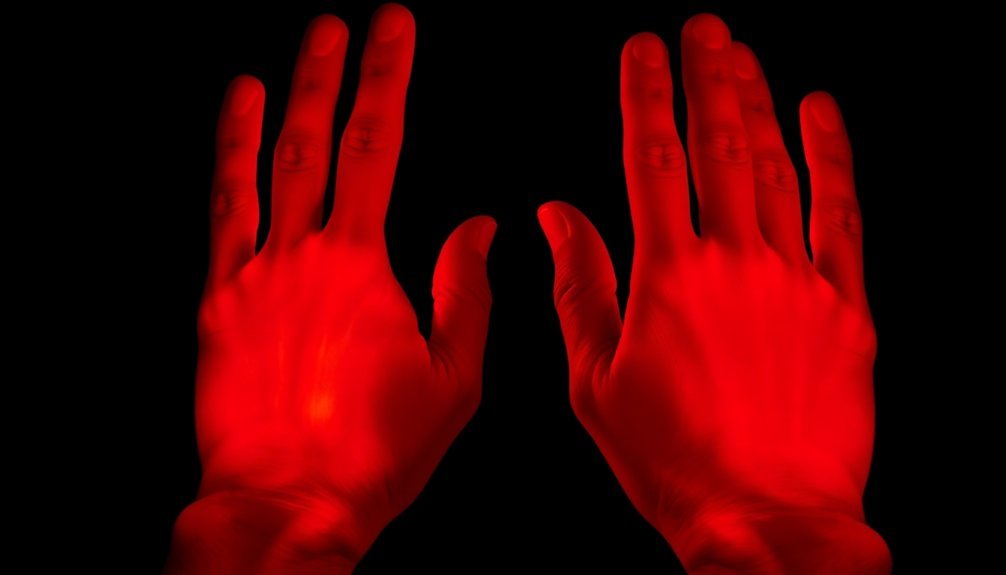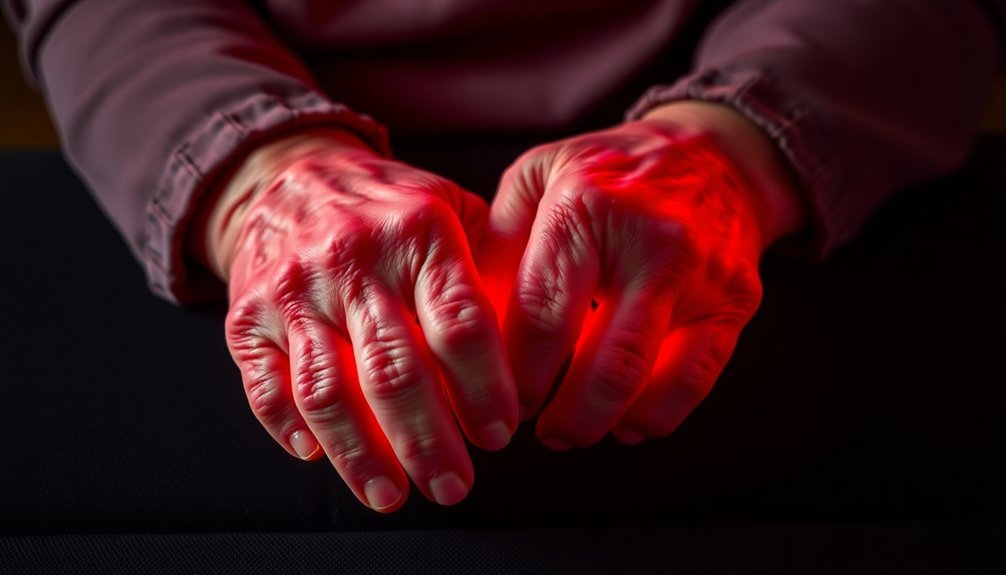Infrared light therapy can effectively soothe your rheumatoid arthritis pain by penetrating deep into your joints and surrounding tissues. The light waves reach 2-7 centimeters beneath your skin, where they trigger your body's natural healing responses. You'll experience reduced inflammation as the therapy improves blood circulation and promotes cellular repair. It works by stimulating endorphin production, your body's natural painkillers, while increasing ATP energy in your cells. Clinical studies show over 50% pain reduction, improved joint mobility, and decreased stiffness with regular treatments. The therapy's combination of pain relief and healing makes it a promising option for managing your RA symptoms. Let's explore how you can incorporate this gentle, non-invasive treatment into your care routine.
Understanding Infrared Light Therapy

In light of recent medical advances, infrared light therapy has emerged as a promising treatment for managing pain and inflammation. When you undergo this therapy, you'll experience the penetrating effects of infrared light wavelengths ranging from 700 to 1,200 nanometers, which can reach 2 to 7 centimeters deep into your tissues, affecting your muscles, nerves, and bones.
What makes infrared therapy particularly effective is its ability to trigger important metabolic changes at the cellular level. Your body responds to the infrared light by releasing nitric oxide, which helps relax your arteries and regulate blood pressure. The therapy also enables mitochondrial enhancement, improving your cells' energy production capabilities.
You'll benefit from enhanced blood circulation, which delivers essential oxygen and nutrients to your damaged tissues, promoting faster healing and repair.
During treatment, you'll notice several physiological responses. Your blood vessels will dilate locally, and you may experience some redness (erythema) in the treated area. The therapy also stimulates your body's production of endorphins – natural painkillers that help reduce your discomfort.
When combined with other treatments like red light therapy, you'll often experience more extensive benefits, making it an effective option for managing your rheumatoid arthritis symptoms.
The Science Behind Pain Relief
Infrared light penetrates deep into your tissues, where it stimulates your cells to produce more ATP, the essential energy source that powers healing and repair.
Within these deep layers, the therapy triggers increased blood flow and cellular regeneration, helping to reduce inflammation and promote natural healing processes. The light reaches up to 7 centimeters beneath your skin to affect muscles, nerves, and bones.
You'll experience enhanced pain relief as the treatment boosts your body's production of endorphins, your natural pain-fighting hormones that work alongside the cellular repair mechanisms.
Cellular ATP Powers Relief
Through groundbreaking scientific research, we now understand how ATP (adenosine triphosphate) powers cellular healing and pain relief in rheumatoid arthritis patients. When you undergo infrared therapy, it directly stimulates your mitochondria to produce more ATP, which serves as your cells' primary energy source.
This increased ATP production triggers a cascade of beneficial effects in your body. Your cells use this energy boost to accelerate tissue repair and regeneration, while simultaneously managing inflammation that's common in rheumatoid arthritis. The activation of ATP leads to purinergic receptor signaling that helps regulate pain transmission.
The ATP binds to specific receptors in your cells, affecting how they respond to pain signals and inflammation.
What's particularly interesting is how ATP breaks down into adenosine, which activates special receptors that decrease pain sensitivity. You'll benefit from both immediate and long-term relief as adenosine creates an anti-inflammatory environment in your tissues.
Studies show that frequency-specific microcurrent therapy can boost ATP production by up to 500% in injured tissues, making it a powerful tool for pain management.
You'll get the best results when infrared therapy is combined with other ATP-boosting treatments, as this thorough approach enhances cellular healing and provides more effective pain relief.
Deep Tissue Healing Action
A remarkable aspect of infrared therapy lies in its ability to penetrate deep beneath your skin's surface, reaching tissues up to 7 centimeters deep. When infrared light reaches your joints and surrounding tissues, it triggers a cascade of healing responses that directly target your rheumatoid arthritis pain.
Your body responds to infrared therapy through several key mechanisms:
- The light waves stimulate your cells to produce nitric oxide, which relaxes and widens your blood vessels, allowing more oxygen and nutrients to reach inflamed areas.
- Your circulation improves dramatically as blood flows more freely through widened vessels, helping to flush out inflammatory proteins.
- The enhanced blood flow delivers healing compounds and anti-inflammatory proteins exactly where you need them most.
- Your cells' repair mechanisms kick into high gear, accelerating tissue regeneration and reducing joint damage.
The wavelengths between 700 and 1,000 nanometers are particularly effective at reaching deep tissues where inflammation occurs. This penetrating action makes infrared therapy uniquely suited for treating rheumatoid arthritis, as it can target inflammation at its source rather than just masking surface-level symptoms. The treatment's ability to increase ATP production helps energize cells throughout your body, supporting natural healing processes.
Endorphin Production Mechanism
Beyond the deep-tissue healing effects, your body's natural pain-fighting system kicks into high gear during infrared therapy sessions. When infrared light penetrates your tissues, it triggers your brain to release powerful endorphins – your body's natural painkillers. These endorphins, particularly beta-endorphins, are even more potent than morphine in managing pain and stress.
During your infrared therapy session, the light waves reach deep into your tissues, stimulating a cascade of metabolic events. Your cells respond by producing more ATP and nitric oxide, which enhance blood circulation and promote healing. Engaging in this therapy is similar to other pleasurable activities and exercises that naturally boost endorphin production in your body.
As your tissues warm up, the therapy activates your body's pain gate mechanism, leading to increased endorphin production in your pituitary gland and hypothalamus.
You'll benefit from this natural pain-relief process without the side effects of conventional medications. Your endorphins attach to specific opioid receptors in your brain, effectively blocking pain signals from reaching nerve cells. This natural response not only helps manage your rheumatoid arthritis pain but also supports your body's healing process through improved circulation and cellular repair.
Benefits For Joint Health

In regards to joint health, infrared therapy delivers powerful benefits for those suffering from rheumatoid arthritis. As the infrared light penetrates deeply into your tissues, it triggers a cascade of healing responses that directly improve your joint mobility and function.
You'll experience enhanced blood circulation, which helps reduce swelling and promotes the repair of damaged connective tissues. Regular sessions can lead to a 50% reduction in pain for those with degenerative joint conditions.
When you undergo infrared therapy, you can expect these improvements in your joint health:
- Your stiff joints will become more flexible as the deep-penetrating heat relaxes surrounding muscles and increases blood flow
- Your range of motion will expand as inflammation subsides and tissue regeneration accelerates
- Your joint pain will decrease through the combined effects of improved circulation and natural healing processes
- Your connective tissues will strengthen as the therapy stimulates collagen production
The therapy's ability to promote tissue regeneration while preventing cell death makes it particularly effective for long-term joint health.
You'll notice that your joints feel less restricted and move more freely, allowing you to perform daily activities with greater ease. This improvement in mobility, combined with reduced swelling, creates a foundation for better joint function over time.
Treatment Methods and Applications
Treatment methods for infrared therapy combine precise heat application with specific light wavelengths to target your arthritic joints effectively. You'll experience temperatures between 120-140°F as electromagnetic radiation penetrates 2-7 centimeters deep into your tissues, affecting muscles, nerves, and bones.
The most effective wavelengths range from 700 to 1,000 nanometers, delivering therapeutic benefits directly to problem areas. The therapy's effectiveness comes from its ability to stimulate ATP production in cells.
You can receive infrared therapy through various methods, including infrared saunas and red light therapy devices. A typical treatment plan involves eight sessions over four weeks, though your healthcare provider may recommend a different schedule based on your needs. You'll find these treatments available at physical rehabilitation centers, spas, or through home-use devices.
During treatment, you'll benefit from increased circulation and cellular repair, which helps reduce inflammation and pain while promoting tissue regeneration. The therapy stimulates endorphin production, improving your mood and decreasing fatigue.
It's a non-invasive option that works well alongside traditional treatments, and you won't experience adverse effects. Before starting infrared therapy, consult with your healthcare provider to determine the most appropriate treatment approach for your condition.
Clinical Research and Evidence

Research findings support the effectiveness of infrared therapy for managing rheumatoid arthritis symptoms. Clinical studies reveal that you'll experience significant improvements in pain and stiffness during treatment periods.
The therapy works by increasing your body's production of nitric oxide and triggering cellular responses that promote healing and reduce inflammation. Standard treatment sessions last 10 to 15 minutes with the IR lamp positioned appropriately from the body.
When you undergo infrared therapy, you'll notice several evidence-backed benefits:
- Your blood circulation improves as vessels dilate, delivering more oxygen and nutrients to affected joints
- Your muscle spasms decrease while nerve conduction velocity increases, leading to better mobility
- Your body produces more growth factors and endorphins, naturally helping to control pain
- Your inflammatory markers decrease as the therapy modulates your immune response
While short-term benefits are well-documented, research shows mixed results for long-term effects. Studies comparing infrared therapy to sham treatments have produced varying outcomes, though most patients report good tolerability with no adverse effects.
The therapy's ability to reduce oxidative stress and promote tissue repair makes it a promising complement to conventional RA treatments, particularly for managing acute pain episodes.
Safe Home Treatment Options
Setting up safe infrared therapy at home requires careful consideration of both equipment and treatment protocols. When choosing your home treatment device, opt for FDA-cleared options that utilize near-infrared light wavelengths between 700-1,000 nanometers, as these have proven most effective for treating rheumatoid arthritis symptoms.
Infrared saunas provide full-body treatment in a controlled environment, while portable devices and therapy pads offer targeted relief for specific joints.
Before starting treatment, make certain you're well-hydrated and haven't eaten a heavy meal. Wear loose-fitting clothes to stay comfortable and allow your body to sweat naturally during sessions.
Start with shorter sessions and gradually increase duration as your body adjusts to the therapy. You don't need to worry about adverse effects, as infrared therapy is well-tolerated by RA patients. However, maintaining proper hydration is essential – drink plenty of water before and after each session.
If you're using a portable device, you can focus the treatment directly on your affected joints for targeted relief, making it an effective option for managing your RA symptoms at home.
Best Practices for Results

To get the best results from infrared therapy for your rheumatoid arthritis pain, you'll need to commit to an eight-session treatment plan spread over four weeks.
You should schedule your sessions at consistent times, allowing enough duration for deep tissue penetration while following your device's specific instructions for distance and intensity.
Your dedication to regular treatments will help maintain long-term benefits, as consistent application is essential for managing pain and preventing symptoms from returning.
Treatment Timing For Success
Success with infrared therapy for rheumatoid arthritis depends heavily on proper timing and consistency of treatments. You'll typically need 10-15 minute sessions, and while some people notice improvements within days, others may need several weeks of consistent use before experiencing significant relief.
For ideal results, you'll want to:
- Start with daily sessions until your symptoms begin improving
- Focus on maintaining the same treatment time each day
- Keep sessions between 10-15 minutes, adjusting based on your response
- Gradually reduce to 3-4 sessions per week once symptoms improve
You don't need to worry about overusing infrared therapy, as it's safe for daily use. However, you'll want to stick with your treatment plan even after you're feeling better. Think of it as maintenance for your joints – consistency is essential for long-term benefits.
While infrared therapy isn't a cure, it works well alongside other treatments like medication and physical therapy. You can choose between home treatments or clinical sessions, but whatever you decide, maintaining a regular schedule will help you achieve the best possible outcomes.
Daily Application Guidelines
Getting the most out of infrared therapy requires following specific daily practices and guidelines. For maximum results, you'll want to schedule 15-30 minute sessions in an infrared sauna that operates between 120-140°F.
Make these sessions part of your regular routine, ideally several times per week, but always consult your healthcare provider first to determine the best frequency for your condition.
Before starting your sessions, make certain you're well-hydrated and monitor your body's response throughout the treatment. The 360-degree infrared heaters will penetrate deep into your tissues and joints, so pay attention to how your body reacts to make necessary adjustments.
You'll benefit from both red and near-infrared light, which can boost cellular repair and increase oxygenation.
Track your symptoms daily, including pain levels, stiffness, and inflammation. If you notice improvements in blood flow and mobility, you're on the right track.
Consider combining infrared therapy with your other treatments for enhanced benefits.
Remember to maintain proper hygiene whether using a private or public facility, and always clean the equipment before and after use to prevent infection risk.
Frequently Asked Questions
Can I Combine Infrared Therapy With Other Arthritis Medications?
Yes, you can safely combine infrared therapy with your arthritis medications. It's a non-invasive treatment that won't interfere with your meds, and it might even help enhance their effectiveness in managing symptoms.
How Long Should I Wait Between Infrared Therapy Sessions?
You should wait 2-3 days between infrared therapy sessions. The recommended frequency is 2-3 times per week, with 20-30 minute sessions. This spacing allows your body to respond ideally to the treatment.
Will Infrared Therapy Work During Arthritis Flare-Ups?
Yes, infrared therapy can effectively help during your arthritis flare-ups. It'll reduce your pain and inflammation while improving joint mobility. Research shows it's safe and won't worsen your symptoms during active flares.
Does Health Insurance Typically Cover Infrared Therapy Treatments?
Your insurance coverage for infrared therapy varies widely. You'll need a doctor's prescription and proof of medical necessity. While some plans cover it for rehabilitation, others may consider it experimental and deny coverage.
Are Certain Types of Infrared Devices Better for Specific Joints?
Yes, you'll find specific devices work better for different joints. Larger wraps suit knees and shoulders, while smaller, flexible devices are ideal for hands and ankles. Choose devices designed for your target area.
In Summary
You'll find infrared therapy offers a promising way to manage your rheumatoid arthritis pain naturally. Whether you're using professional treatments or home devices, consistent application can help reduce inflammation and increase joint mobility. Start slowly, follow safety guidelines, and you'll likely notice improvements in your comfort level. While it's not a cure, infrared therapy can be an effective part of your overall pain management strategy.





Leave a Reply